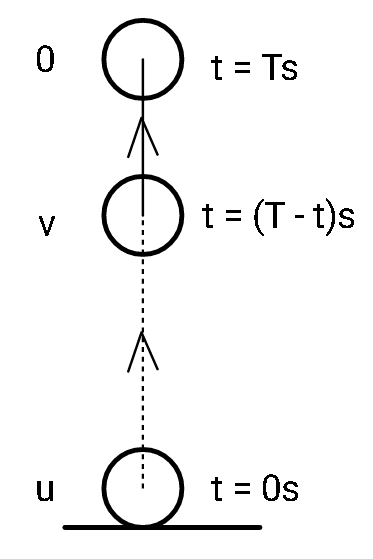
If a ball is thrown vertically upwards with speed u, the distance covered during the last t seconds of its ascent is:
A. ut
B. $\dfrac{1}{2}gt^2$
C. $ut - \dfrac{1}{2}gt^2$
D. (u + gt)t
Answer
510.8k+ views
Hint: When the ball will be thrown upwards it will undergo retardation due to gravity (g). In the last t seconds of its path during its ascent, it will start with some velocity v and reach a final velocity of zero before it starts to fall back (descent).
Formula used:
The final velocity of a body undergoing acceleration a with initial velocity u, in time interval t is:
v = u + at .
The distance covered by the (same) body in time interval t is given by:
$s = ut + \dfrac{1}{2}at^2$ .
Complete answer:
We are given that the ball is thrown vertically upwards with an initial velocity of u. We break the trajectory of ascent into three different times.
1. At t= 0, velocity is u
2. At t = T, velocity reaches zero (Let the total time of ascent be T).
3. At t = T-t, let the velocity be some v.
We are to determine the distance traveled between the points where time is T-t and T ( as T - (T-t) = t s).

First, let us use the first law of motion to determine the velocity that the ball will attain after a time T-t s,
v = u + at
We know that a = -g due to retardation, so:
v = u - g(T-t).
For the second half of the journey, from T-t seconds to T seconds, we get
0 = v - gt
so, v= gt.
This will be the initial velocity for the ball when it enters the last t seconds of its ascent.
Therefore, we write in second law of motion:
$s = (gt)t - \dfrac{1}{2}gt^2$
$s = \dfrac{1}{2}gt^2$
In last t seconds, the ball will cover a distance of $\dfrac{1}{2}gt^2$
Therefore, the correct answer is option (B).
Note:
Since the ball is undergoing retardation one should not forget to put a minus sign in front of g. Also one could get confused in the use of t. We always use a difference of final and initial time in the laws of motion. Here, in the first part of the ascent, the time interval was T-t - 0 = T-t seconds and in the second part it was T - (T-t) = t seconds.
Formula used:
The final velocity of a body undergoing acceleration a with initial velocity u, in time interval t is:
v = u + at .
The distance covered by the (same) body in time interval t is given by:
$s = ut + \dfrac{1}{2}at^2$ .
Complete answer:
We are given that the ball is thrown vertically upwards with an initial velocity of u. We break the trajectory of ascent into three different times.
1. At t= 0, velocity is u
2. At t = T, velocity reaches zero (Let the total time of ascent be T).
3. At t = T-t, let the velocity be some v.
We are to determine the distance traveled between the points where time is T-t and T ( as T - (T-t) = t s).

First, let us use the first law of motion to determine the velocity that the ball will attain after a time T-t s,
v = u + at
We know that a = -g due to retardation, so:
v = u - g(T-t).
For the second half of the journey, from T-t seconds to T seconds, we get
0 = v - gt
so, v= gt.
This will be the initial velocity for the ball when it enters the last t seconds of its ascent.
Therefore, we write in second law of motion:
$s = (gt)t - \dfrac{1}{2}gt^2$
$s = \dfrac{1}{2}gt^2$
In last t seconds, the ball will cover a distance of $\dfrac{1}{2}gt^2$
Therefore, the correct answer is option (B).
Note:
Since the ball is undergoing retardation one should not forget to put a minus sign in front of g. Also one could get confused in the use of t. We always use a difference of final and initial time in the laws of motion. Here, in the first part of the ascent, the time interval was T-t - 0 = T-t seconds and in the second part it was T - (T-t) = t seconds.
Recently Updated Pages
Why are manures considered better than fertilizers class 11 biology CBSE

Find the coordinates of the midpoint of the line segment class 11 maths CBSE

Distinguish between static friction limiting friction class 11 physics CBSE

The Chairman of the constituent Assembly was A Jawaharlal class 11 social science CBSE

The first National Commission on Labour NCL submitted class 11 social science CBSE

Number of all subshell of n + l 7 is A 4 B 5 C 6 D class 11 chemistry CBSE

Trending doubts
What is meant by exothermic and endothermic reactions class 11 chemistry CBSE

10 examples of friction in our daily life

One Metric ton is equal to kg A 10000 B 1000 C 100 class 11 physics CBSE

1 Quintal is equal to a 110 kg b 10 kg c 100kg d 1000 class 11 physics CBSE

Difference Between Prokaryotic Cells and Eukaryotic Cells

What are Quantum numbers Explain the quantum number class 11 chemistry CBSE




